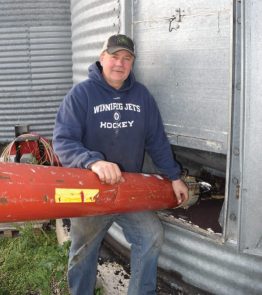Band N to reduce losses
“We usually have lots of moisture and, importantly, lots of heat in the spring. That combination increases volatilization, which is why, for us, spring broadcast has huge potential for loss. Fall banding is way less risky in
our soil type.”

When Brad Erb switched seeding tools, it forced a shift in his nitrogen application strategy. The farmer from Oak Bluff, Manitoba had been applying anhydrous ammonia at the time of seeding through the mid-row bander on his drill. Based on old and new research, he knows that spring banding applications are the best way to limit nitrogen losses. He also knows from experience that time-of-seeding is really the only spring banding option for his heavy Red River soils.
“With our clays, any spring field work done before seeding destroys the seed bed,” he says.
But then Erb bought a new disc drill that did not have the mid-row banding option. And as a disc drill, he couldn’t risk putting nitrogen down that narrow opening with the seed. So, he needed to add another pass for nitrogen.
At the same time Erb was making his decision, he was hosting nitrogen application trials for University of Manitoba researcher Mario Tenuta. The canola-grower-funded study was comparing canola yield results for surface application, shallow banding and deep banding of nitrogen at 100 per cent and 70 per cent of recommended rates. (Read the full summary.)
The study, which was confined to east-central Manitoba, confirmed that losses are much higher with fall surface applications and that shallow- or deep-banding is better than surface applications in the spring.
With the amount farmers spend on nitrogen, this information provides a good payback.
“I rely on this research and a lot of my own on-farm testing to make the right economic decisions,” Erb says.
Recent studies such as Tenuta’s are also important to provide modern context for older studies that have been driving decisions for decades.
With every nitrogen decision Erb makes, he thinks about the “relative efficiencies” table created in 1975 based on Al Ridley’s “Effect of nitrogen fertilizers, time and method of placement on yields of barley.” If spring broadcast is 100 per cent efficient, Ridley concluded that other options had relative efficiencies as follows: Fall broadcast
80 per cent, Fall band 100 per cent, Spring band 120 per cent.
| Time and Method | Relative Values |
|---|---|
| Spring broadcast | 100% |
| Spring banded | 120% |
| Fall broadcast | 80% |
| Fall banded | 100% |
| Source: https://www.gov.mb.ca/agriculture/crops/soil-fertility/soil-fertility-guide/nitrogen.html#relative | |
In short, to get the most return from nitrogen, spring banding is the best option. Tenuta’s canola research from 40 years later confirms that this is still true.
So how does Erb apply nitrogen if he can’t band it at the time of seeding or before seeding?
Fall banding is his best compromise for timing, logistics and reduced losses, he says. He bands when soil temperature drops below 10°C so that soil microbial activity and resulting nitrogen loss is minimized. He adds that, for his farm, fall banding is better than spring broadcast – even if Ridley’s relative efficiencies suggest they’re about equal.
“Fall banding is way less risky in our soil type,” Erb says. “We usually have lots of moisture and, importantly, lots of heat in the spring. That combination increases volatilization, which is why, for us, spring broadcast has huge potential for loss.”
Given the amount canola farmers pay for their nitrogen input each year, the payback from research to quantify losses and to choose best practices for nitrogen-use efficiency can be many thousands of dollars per farm per year.





